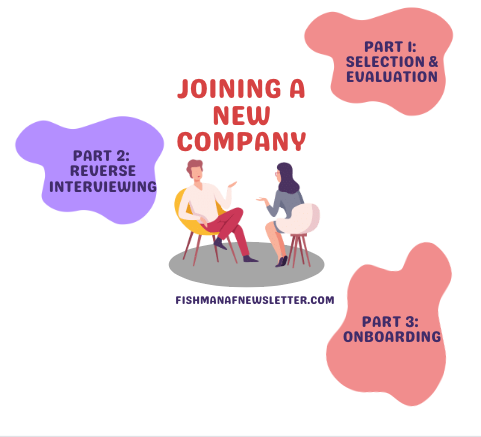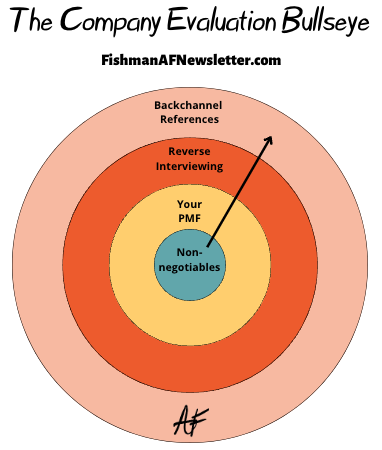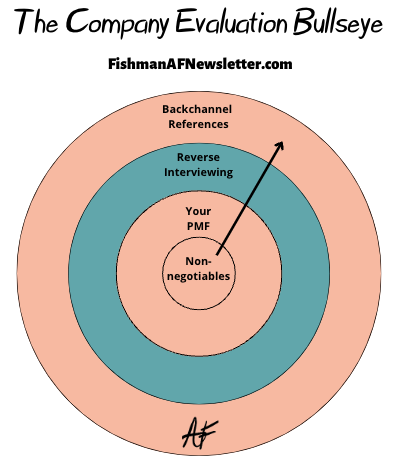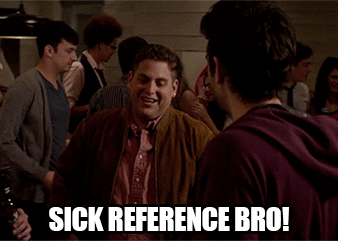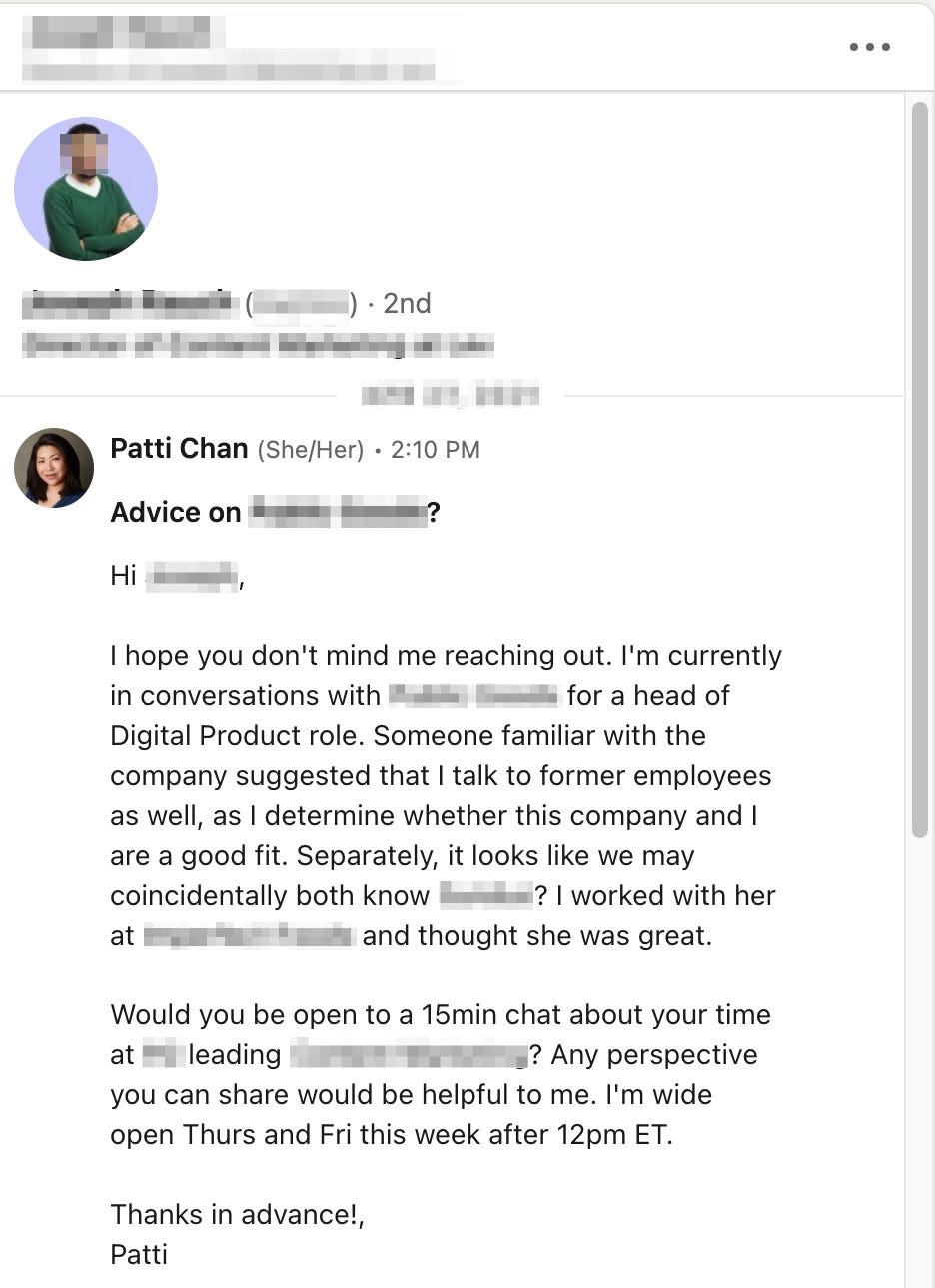Reverse Interviewing—How to interview a company as well as they interview you
Part 2 of a 3 part series on how to successfully join a new company with lessons from leaders at Tile, Contentful, Reforge, Thumbtack, Zillow and more!
Hi there, it’s Adam. 🤗 Welcome to my weekly newsletter. I started this newsletter to provide a no-bullshit, guided approach to solving some of the hardest problems for people and companies. That includes Growth, Product, company building and parenting while working. Subscribe and never miss an issue. Questions? Ask them here.
This is part two of a three-part series on how to successfully join a new company. Interested in hiring? Read my last series where I break down the process for making your first Growth hire.
With the continued layoff crunch in the tech world and a job market flush with great talent it’s important for candidates to understand how best to identify, choose, and onboard successfully to their next role.
Part 2: Reverse Interviewing—How to interview a company as well as they interview you ⬅️ (this post)
In today’s post I’ll cover:
What is Reverse Interviewing?
How to plan, structure and prepare questions
Back-channel references
What to do next?
In my last post I described a framework for company selection, something I call The New PMF. A lot of people replied to my post sharing their own mistakes with company selection or how their own system of evaluation changed over time.
A few that stuck out to me:
Niels Holvoet, from The Venture Whisperer:
“Sooner or later, when a culture doesn't fit your own values, the job will make you miserable. Now, for me culture including mission, people and how these people make (financial) decisions are on the top of my list when evaluating companies.”
And from a reader named Josh:
“I do have one other thing I *always* think about now (and one thing that sometimes makes sense to think about):
Is this a tech company? Or a tech-enabled company. Not unrelated to fiscal discipline, but at a tech company the problems you'll help discover and the solutions you'll help design, build, and release are the direct inputs to the company's value. Value creation is the primary measure of Product success at tech companies. But tech-enabled companies are different - at a tech enabled company you're a cost center. It's not that the work you're doing isn't critical but you're enabling some larger effort or initiative being driven by the real value creators.”
I really appreciate these replies, the shared insights, and the support for this newsletter; so thank you!
In The New PMF I identified a few ways to evaluate across the dimensions of People, Mission, and Financials. This post goes deeper on two particular techniques that I have found very valuable in uncovering the good, the bad, and the ugly in company evaluation: reverse interviewing and back-channel references. I also pulled in some of my network’s favorite reverse interview questions to share with you as well as a fun back-channel story from my time at Zimride and Lyft.
What is Reverse Interviewing?
A reverse interview is very much what it sounds like: instead of a company interviewing you the relationship is flipped and you interview the company.
This is important for several reasons. In The New PMF I said that interviewing is a lot like buying a used car. The seller knows more than you and they are gunning for that commission. The reverse interview is your chance to take back some of the power and information asymmetry of the interview process.
Here are two other reasons why reverse interviewing is important:
You get to sell. The questions you ask are an effective way to demonstrate to the company how you think and what you value. You can show proactivity, deeper thinking, preparation, and enthusiasm through the questions you ask of them. You take back control of the process.
Test the [culture/strategy/vision/fill-in-the-blank]. They say they value transparency and honesty. Time to prove it. How they answer your direct, tough questions about the company will give you a view into how they’ll handle the tough questions that come up on the job. You’ll be able to get a better sense of the good, bad and ugly of working there with a solid reverse interviewing strategy.
If you’re here you probably already believe that Reverse Interviewing is important so let’s get into how to do it.
How to plan, structure and prepare questions
The first step, before structure and question preparation, is actually figuring out when to introduce the Reverse Interview.
The answer to this is simple: when you already have the job offer negotiated and ready to sign.
But Adam, you just said that Reverse Interviewing helps you sell yourself? I don’t need to sell myself if it’s happening after I’ve got the offer, right? The answer to this is two-fold. First, you’re always selling. You can use reverse interview techniques during the formal interview process to shape the questions you ask each interviewer at the end of your session. Second, the real, tough, make-people-uncomfortable reverse interview questions should come at the point where you know they want you. Not when you’re still trying to get the job.
This doesn’t mean you should ask “tell me about the culture here” softball questions during the interview process. Don’t do that; it could actually backfire on you. But since our lizard brain wants to play it safe when we’re trying to impress people remember that it’ll be a lot easier for you to ask hard-hitting questions once you know you’ve got the job.
Your approach should follow a framework I call the Company Evaluation Bullseye.
With this framework we work from the center of the bullseye outward.
Your first challenge is to determine both your non-negotiables and your own, personal New PMF. It took me years to figure this out for myself, but through a process of self-inquiry you should be able to do this much faster. Knowing these first two helps you structure the right reverse interview questions.
Much like the internal clarity process outlined in my article on coaching you’ll want to go through a similar exercise here. In my experience you can use this same process to figure out what it is you need to be more satisfied with your career choices.
I like to approach this process by asking myself a series of compounding questions, such as:
When I was happiest in my career, what was I doing?
When I was miserable in my career, what was I doing?
What do I consider my best work?
Who was I working with when I did my best work?
What values do I live by every day?
Who are the people whose value system most closely aligns with mine?
Who have I most enjoyed working with?
What makes me feel fulfilled at work?
What do I want to be known for?
From these questions you can then drill deeper by asking “why” with each one, practicing a popular technique called the “Five Whys.” It helps you get to the root of what you want.
It might look something like this overly-simplified, hypothetical example:
When I was happiest in my career, what was I doing?
I was fixing cars.
{Why} I like working with my hands.
{Why} I can see tangible output.
{Why} Tangible output makes me feel productive
{Why} I like feeling productive.
{Why} It makes me feel fulfilled.
Okay, what have we learned here?
I like jobs where I can see tangible results because it makes me feel productive.
You know where else you can see tangible results? Writing newsletters.
Just kidding. It’s a thankless job.
So what’s the difference between the non-negotiables and the New PMF? Simple: non-negotiables are rigid and your personal PMF doesn’t have to be.
Throughout your self-inquiry process you’ll determine a list of important criteria. Some of these criteria will be absolutely, unequivocally, 100% non-negotiable. That means that you won’t even entertain a company or a role that doesn’t meet those set of requirements. No compromises.
Examples of a few of my non-negotiables:
Product and Technology drive the company.
Ability to talk to customers regularly; no gatekeepers.
Build to solve customer problems; not sell features.
Your non-negotiables will likely look very different than mine, but it’s important to have them.
Your PMF can be more flexible. You might have 3-5 pillars that are important and the company indexes highly in 3 or 4, but needs to improve in one. That could be okay for you which means it’s not a show-stopper. However, you’ll still want to craft questions that help you get to the truth of the strength of those pillars.
Once you have your non-negotiables and PMF crafted I recommend organizing them on a whiteboard, spreadsheet, or [insert organizational tool of choice] and grouping by theme.
Some possible themes for you:
Culture
Role & Expectations
Goal-setting
Strategy
Communication
You can then create a table with rows for the themes and columns for questions and who is best to answer them. This second part is important because getting to the truth requires asking questions to the person or people best-suited to answer them. It can also be helpful to ask the same question to a few people at the company to see how similar their answer is.
Use this sample table as a starting point (Miro link).
I asked my network for their best reverse interview questions and I’ve organized them here for you along with some of their thoughts on why to ask them and what to look for in an answer.
Culture
Every company has people that join who aren’t a fit and don’t last long. What are the characteristics of those people relative to your culture? - Mark Fiske, Operating Partner at H.I.G. Capital
How do you create an inclusive culture on your team? - Jossie Haines, fmr VP Engineering at Tile now Executive Coach
What's a recent example of your having disagreed with a decision a member of your team made but you let it ride anyway? - Derek DeHart, Lead PM at Vouch Insurance
Who was the last person on your team promoted? What did they do to earn that promotion?
Strategy
If you were CEO, what would you be doing differently? - Seth Berman, VP Growth Marketing at Contentful
What do I have to believe for you to get to a billion dollars in annual revenue? - Matt Greenberg, CTO at Reforge
What could have caused the company to fail in delivering its mission three years from now? - Ben Lauzier, fmr VP Product at Thumbtack
What are three challenges that are top of mind for you? - Yoav Morami, Sr. PM at Melio
Who holds the Product Vision? - Raymond Cha, Sr. PM at LoanStreet
Tell me about something you have removed from the product recently. Take me through what happened and how you identified it. - Ashley Rolfmore, Product Manager at CyberOwl
Role & Expectations
You’re looking for a leader who is a change agent - how would you characterize the “from” and the “to” around that change? Alissa Reiter, CMO at Evernow, fmr Zillow
Why would I fail in this role? - Ben Lauzier, fmr VP Product at Thumbtack
What were you surprised by (positively or negatively) when you onboarded? What about now that you’ve been here for awhile? - Elena Luneva, GM at Braintrust fmr Product Leader at Nextdoor
Can you lay out your expectations for this role?
Goal-setting
How is the Product Roadmap currently put together? - Ashley Rolfmore, Product Manager at CyberOwl
Do you use a particular framework for goal-setting at the company? For example, can you tell me what my OKRs would be when I join?
Can you walk me through the company’s financial plan for the year?
Communication
What was the last, big internal announcement you made? How was that communicated?
What communication tools does the company use? Do you have rules around how you should use each one?
Will you ever send me a Slack message after hours? Do you expect a response outside of normal working hours?
A note on how to ask these questions:
Interviewing is a skill and reverse-interviewing is no different. When you’re interviewing someone for information and truth don’t let them off the hook with a general answer or a hypothetical story. Continue digging deeper by asking how and then pushing further by asking for a specific example. If they can’t give you one then they’re probably not being truthful with you.
Now that you’ve asked people inside of the company and created your Reverse Interview Guide it’s time to apply the same rigor to back-channel references.
Back-channel references
This is, without a doubt, one of my favorite parts of company evaluation. Most people on the interviewer side use reference checks as sort of a last step, check-the-box exercise. As the candidate, a well-executed set of backchannel references can be the deciding factor on joining a team, a company, or a leader.
As part of joining a new company you’ll be getting a new boss. That could be the CEO, it could be the VP of Product, or it could be a Marketing Manager. Regardless of level, ask them for the contact information of three people they managed directly in a prior role. If they won’t provide that information, that's a large, red, warning light.
At this point, I’d probably bow out of the process. But if you feel like there are valid reasons they can’t do that—maybe they haven’t managed that many people in the past—then you can still do some of your own digging. This is where LinkedIn and other online communities can help. Look for related connections or people you know at past companies they’ve worked at and reach out to them directly.
That outreach might look something like this:
Once you’ve found the right people and confirmed that they’re willing to speak with you. It’s time for the interrogation to begin!
In many ways these conversations can be the same as your reverse interviews and the benefit is that they’re even more direct and candid since.
Additional questions to ask back-channel references:
Tell me about [prior manager’s] feedback style? What were conversations like when you were successful; what about when you made a mistake?
How did you [prior manager] work with you on goal setting?
What did it take to get promoted under [prior manager] (assuming they had a promotion).
Tell me about the [product/growth/company] strategy created by [prior manager]. (assuming they created strategy)
Other questions when speaking talking to people who didn’t work for your potential manager but did work at the company you’re considering:
Why did you leave [company]? (assuming they left)
How did decisions get made at [company]?
How clear were the executives in communicating strategy and expectations? Can you give me examples?
What is something you disagreed with at [company]?
Do you feel that all voices were respected and heard at [company]?
Did anything ever make you uncomfortable at [company]?
Now, a story on back-channeling from my days at Zimride and Lyft.
When Logan Green, co-founder and CEO of Zimride (now Lyft), was raising the Series A for Zimride in 2011 he spoke to a lot of investors. One of those investors was Raj Kapoor at Mayfield (now co-founder of Climactic). Logan wasn’t too far out of college when he started Zimride and Raj wanted to do some back-channeling on him prior to making an investment. Rather than ask Logan for references he did his own digging and managed to find Logan’s High School principal. He reached out to see what that principal remembered of Logan. As it turns out, a lot. Allegedly, Logan had once programmed an auto-dialer to call through the school student directory with a recorded message telling parents that school was closed that day. Chaos ensued.
Raj was so impressed with the creativity, ingenuity, and willingness to stretch the rules that he made the investment. Lyft’s market cap is now over $6B.
What to do next?
Your immediate next step after capturing all of your reverse interview and back-channel feedback in a document is to make your decision. I can’t tell you how to make that decision, instead I can highlight where I’ve stumbled (or succeeded) in my career.
Every time I haven’t conducted a proper reverse interview or backchannel, compromised on my non-negotiables and company PMF, or ignored that spider sense that tells me something is wrong; I’ve had a bad experience. Doing these activities doesn’t guarantee success but it sure makes it a lot more likely.
In my final post in this series I’ll share how you construct a bulletproof onboarding plan for yourself. You can apply product onboarding techniques to your own “activation” experience at a new company. I’ll add real-life experiences through interviewing and sharing the recent new company onboarding journeys of several fantastic people.
Subscribe now so you get this next article delivered right to your inbox!
I look forward to sharing Part 3: Your Activation Experience—onboarding successfully in your first 90 days.
See you next week!



